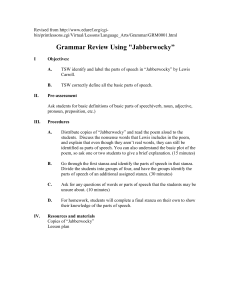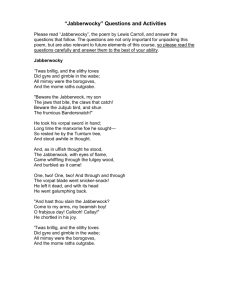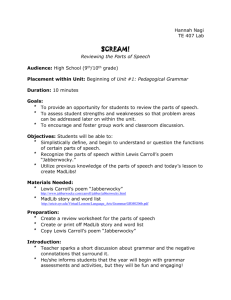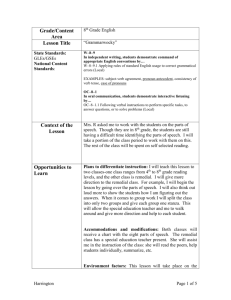GRADE 7 ELA EXEMPLAR LESSON – Teacher Copy Quarter 2
advertisement
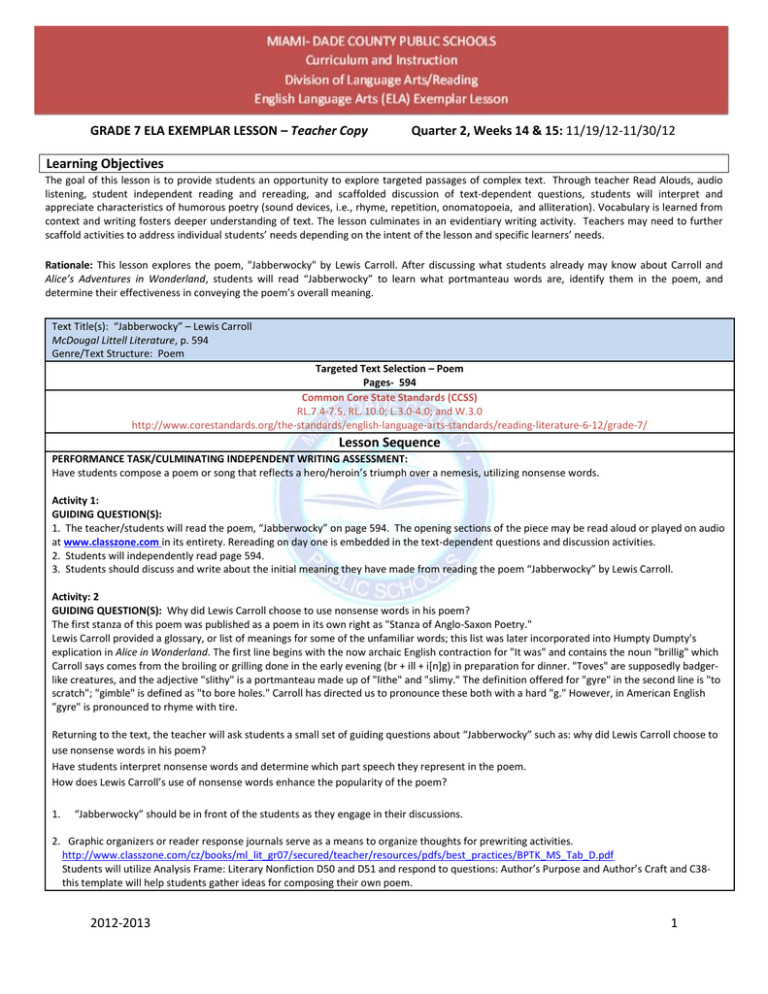
GRADE 7 ELA EXEMPLAR LESSON – Teacher Copy Quarter 2, Weeks 14 & 15: 11/19/12-11/30/12 Learning Objectives The goal of this lesson is to provide students an opportunity to explore targeted passages of complex text. Through teacher Read Alouds, audio listening, student independent reading and rereading, and scaffolded discussion of text-dependent questions, students will interpret and appreciate characteristics of humorous poetry (sound devices, i.e., rhyme, repetition, onomatopoeia, and alliteration). Vocabulary is learned from context and writing fosters deeper understanding of text. The lesson culminates in an evidentiary writing activity. Teachers may need to further scaffold activities to address individual students’ needs depending on the intent of the lesson and specific learners’ needs. Rationale: This lesson explores the poem, "Jabberwocky" by Lewis Carroll. After discussing what students already may know about Carroll and Alice’s Adventures in Wonderland, students will read “Jabberwocky” to learn what portmanteau words are, identify them in the poem, and determine their effectiveness in conveying the poem’s overall meaning. Text Title(s): “Jabberwocky” – Lewis Carroll McDougal Littell Literature, p. 594 Genre/Text Structure: Poem Targeted Text Selection – Poem Pages- 594 Common Core State Standards (CCSS) RL.7.4-7.5, RL. 10.0; L.3.0-4.0; and W.3.0 http://www.corestandards.org/the-standards/english-language-arts-standards/reading-literature-6-12/grade-7/ Lesson Sequence PERFORMANCE TASK/CULMINATING INDEPENDENT WRITING ASSESSMENT: Have students compose a poem or song that reflects a hero/heroin’s triumph over a nemesis, utilizing nonsense words. Activity 1: GUIDING QUESTION(S): 1. The teacher/students will read the poem, “Jabberwocky” on page 594. The opening sections of the piece may be read aloud or played on audio at www.classzone.com in its entirety. Rereading on day one is embedded in the text-dependent questions and discussion activities. 2. Students will independently read page 594. 3. Students should discuss and write about the initial meaning they have made from reading the poem “Jabberwocky” by Lewis Carroll. Activity: 2 GUIDING QUESTION(S): Why did Lewis Carroll choose to use nonsense words in his poem? The first stanza of this poem was published as a poem in its own right as "Stanza of Anglo-Saxon Poetry." Lewis Carroll provided a glossary, or list of meanings for some of the unfamiliar words; this list was later incorporated into Humpty Dumpty's explication in Alice in Wonderland. The first line begins with the now archaic English contraction for "It was" and contains the noun "brillig" which Carroll says comes from the broiling or grilling done in the early evening (br + ill + i[n]g) in preparation for dinner. "Toves" are supposedly badgerlike creatures, and the adjective "slithy" is a portmanteau made up of "lithe" and "slimy." The definition offered for "gyre" in the second line is "to scratch"; "gimble" is defined as "to bore holes." Carroll has directed us to pronounce these both with a hard "g." However, in American English "gyre" is pronounced to rhyme with tire. Returning to the text, the teacher will ask students a small set of guiding questions about “Jabberwocky” such as: why did Lewis Carroll choose to use nonsense words in his poem? Have students interpret nonsense words and determine which part speech they represent in the poem. How does Lewis Carroll’s use of nonsense words enhance the popularity of the poem? 1. “Jabberwocky” should be in front of the students as they engage in their discussions. 2. Graphic organizers or reader response journals serve as a means to organize thoughts for prewriting activities. http://www.classzone.com/cz/books/ml_lit_gr07/secured/teacher/resources/pdfs/best_practices/BPTK_MS_Tab_D.pdf Students will utilize Analysis Frame: Literary Nonfiction D50 and D51 and respond to questions: Author’s Purpose and Author’s Craft and C38this template will help students gather ideas for composing their own poem. 2012-2013 1 GRADE 7 ELA EXEMPLAR LESSON Quarter 2, Weeks 14 & 15: 11/19/12-11/30/12 3. Respond in Writing: After a read through of the poem, "Jabberwocky," the students will be able to: Explain the actions of the poem Identify the various parts of speech in the poem "Jabberwocky" such as; nouns, verbs, pronouns, adjectives, adverbs and prepositions. Underline the nonsense words Decipher the possible meaning of the nonsense words Replace words to create their own Jabberwocky-type poem 4. Media connections can be found at www.classzone.com or www.discoveryeducation.com. Activity 3: GUIDING QUESTION(S): 1. What did the slithy toves do? 2. How did the borogroves act? 3. Who should be shunned? 4. Describe the sword. 5. What kind of foe was sought? 6. Describe the thought he had while he stood. 7. What type of wood did the Jabberwocky whiffle through? 8. Describe the sound the blade made. 9. What type of day was it after the Jabberwocky was slain? 10. Tell what the man chortled in joy. Activity 4: Divide the class into pairs, and have each read the poem out loud to his or her partner. After reading, they should work together to make a list of all the words they suspect are portmanteau. If the word is in the dictionary, they should record the definition and the words from which it is derived. If it isn’t listed, they should try to determine what two or more words it may be made from. Targeted Text Selection Vocabulary Teacher Activities and Techniques Page 594, Lines _______ Text-Dependent Questions ‘Twas brillig, and the slithy toves Return to the text, and ask students a small set of guiding 1. frumious (fuming, furious) questions about the targeted section. Did gyre and gimble in the wabe; 2. uffish (gruffish, roughish, huffish) All mimsy were the borogoves, 3. burble (bleat, murmer, warble) (Q1) What makes Lewis Carroll’s poem, “Jabberwocky” still And the mome raths outgrabe. 4. mimsy (flimsy, miserable) popular after so many years? 5. mome (from home) "Beware the Jabberwock, my son! Possible answer. 6. galumph (gallop, jump) The jaws that bite, the claws that catch! One of the most appealing factors in Lewis Carroll's 7. slithy (lythe, slimy) Beware the Jubjub bird, and shun "Jabberwocky" is the sheer timelessness of the poem's 8. frabjous (fabulous, joyous) The frumious Bandersnatch!" setting. The boy's encounter with the mysterious Jabberwocky beast has no specific reference point in history. 9. chortle (chuckle, snort) This factor boosts the poem's universal appeal, for He took his vorpal sword in hand: "Jabberwocky" is capable of captivating readers of any era— Long time the manxome foe he sought— Elizabethan, Victorian, Industrial, Computer, or otherwise. So rested he by the Tumtum tree, Although the poem was written and published at the height And stood awhile in thought. of Victorian England, no special knowledge of that era is required in order to understand and enjoy the poem. And, as in uffish thought he stood, The Jabberwock, with eyes of flame , Came whiffling through the tulgey wood, And burbled as it came! One, two! One, two! And through and through The vorpal blade went snicker-snack! He left it dead, and with its head He went galumphing back. 2012-2013 2 GRADE 7 ELA EXEMPLAR LESSON Quarter 2, Weeks 14 & 15: 11/19/12-11/30/12 "And, hast thou slain the Jabberwock? Come to my arms, my beamish boy! O frabjous day! Callooh! Callay!" He chortled in his joy. 'Twas brillig, and the slithy toves Did gyre and gimble in the wabe: All mimsy were the borogoves, And the mome raths outgrabe. 1. What did the slithy toves do? 2. How did the borogroves act? 3. Who should be shunned? 4. Describe the sword. 5. What kind of foe was sought? 6. Describe the thought he had while he stood. 7. What type of wood did the Jabberwocky whiffle through? 8. Describe the sound the blade made. 9. What type of day was it after the Jabberwocky was slain? 10. Tell what the man chortled in joy. (Q2) In lines _____,? Possible answers 1. The slithy toves were Gyre and gimble in the wabe. 2. The borogrves acted mimsy. 3. Shun the frumious Bandersnatch. 4. The vorpal sword. 5. The manxome foe was fought. 6. An uffish thought he stood. 7. He whiffled through tulgey wood. 8. The vorpal blade went snicker-snack! 9. He had an O frabjous day. 10. He chortled with joy, Callooh! Callay! First stanza: ‘Twas brillig, and the slithy toves Did gyre and gimble in the wabe: All mimsy were the borogoves, And the mome raths outgrabe. (Q3) Describe the syllable pattern Lewis Carroll used in his poem, “Jabberwocky”. Possible answer. Carroll also plays with the syllable pattern, with each of the first three lines of a stanza having eight syllables and the last line six, except in the third stanza, where it might be said that the third line "borrows" a syllable from the last. Third stanza: He took his vorpal sword in hand: Long time the manxome foe he sought— So rested he by the Tumtum tree, And stood awhile in thought. Cross Genre Connections OR Across Text or Non-Text Sources: “Alice's Adventures in Wonderland”, Chapter 1 - Down the Rabbit-Hole Down, down, down. Would the fall never come to an end! `I wonder how many miles I've fallen by this time?' she said aloud. `I must be getting somewhere near the centre of the earth. Let me see: that would be four thousand miles down , I think--' (for, you see, Alice had learnt several things of this sort in her lessons in the schoolroom, and though this was not a very good opportunity for showing off her knowledge, as there was no one to listen to her, still it was good practice to say it over) `--yes, that's about the right distance--but then I wonder what 2012-2013 The ballad-stanza is usually four lines rhymed abcb, in which the lines have a syllable pattern of 8, 6, 8, 6. Note how the third, fifth, and sixth stanzas of the poem follow this rhyme scheme, with the others rhyming abab. (Q4) Possible answer. Readers and critics of Alice's Adventures in Wonderland point out that the girl's experiences in the world at the bottom of the rabbit hole are similar to the dreams (sometimes, nightmares) that most human beings have, which, may hold true from the poem “Jabbberwocky”. Creative Comparison of Characters Many small, weak, young, or innocent characters like Alice encounter characters who frighten or overpower them. Have students write a further adventure for Alice, in which she encounters a character from another literary work“Jabberwocky”. Tell students that their episodes should incorporate Carroll's stylistic devices and philosophic beliefs: distortion, humor, and the triumph of the weak over the strong. 3 GRADE 7 ELA EXEMPLAR LESSON Quarter 2, Weeks 14 & 15: 11/19/12-11/30/12 Latitude or Longitude I've got to?' (Alice had no idea what Latitude was, or Longitude either, but thought they were nice grand words to say.) Presently she began again. `I wonder if I shall fall right through the earth! How funny it'll seem to come out among the people that walk with their heads downward! The Antipathies, I think--' (she was rather glad there was no one listening, this time, as it didn't sound at all the right word) `--but I shall have to ask them what the name of the country is, you know. Please, Ma' am, is this New Zealand or Australia?' (and she tried to curtsey as she spoke-- fancy curtseying as you're falling through the air! Do you think you could manage it?) `And what an ignorant little girl she'll think me for asking! No, it'll never do to ask: perhaps I shall see it written up somewhere.' Down, down, down. There was nothing else to do, so Alice soon began talking again. `Dinah'll miss me very much tonight, I should think!' (Dinah was the cat .) `I hope they'll remember her saucer of milk at tea-time. Dinah my dear! I wish you were down here with me! There are no mice in the air, I'm afraid, but you might catch a bat, and that's very like a mouse, you know. But do cats eat bats, I wonder?' And here Alice began to get rather sleepy, and went on saying to herself, in a dreamy sort of way, `Do cats eat bats? Do cats eat bats?' and sometimes, `Do bats eat cats?' for, you see, as she couldn't answer either question, it didn't much matter which way she put it. She felt that she was dozing off, and had just begun to dream that she was walking hand in hand with Dinah, and saying to her very earnestly, `Now, Dinah, tell me the truth: did you ever eat a bat?' when suddenly, thump! thump! down she came upon a heap of sticks and dry leaves, and the fall was over. Formative Assessment/ Rubrics Class discussion(s) on text-dependent comprehension questions OR writing responses (graphic organizers, reader response journals, or prewriting activities) ______ serve as formative assessments. Summative Assessment/Culminating Independent Writing Task: www.classzone.com Writing Directions: Have students translate the poem “Jabberwocky” into a story; translate the portmanteau words into show not tell descriptions of the main characters. 2012-2013 4 GRADE 7 ELA EXEMPLAR LESSON Quarter 2, Weeks 14 & 15: 11/19/12-11/30/12 Students will write a one page narratives essay to develop real or imagined experiences or events using effective technique, relevant descriptive details, and well-structured event sequences. Creative Comparison of Characters Many small, weak, young, or innocent characters like Alice encounter characters who frighten or overpower them. Have students write a further adventure for Alice, in which she encounters a character from another literary work. Extension Activities/Further Resources Related Links: Translations, parodies, and other variants of Lewis Carroll's "Jabberwocky" http://www76.pair.com/keithlim/jabber wocky/index.html Possible Answers: Tell students that their episodes should incorporate Carroll's stylistic devices and philosophic beliefs: distortion, humor, and the triumph of the weak over the strong. Technology: www.discoveryeducation.com – (see links embedded in pacing guide) www.classzone.com Graphic Organizers at www.classzone.com Interdisciplinary Connection-Art: Have students describe the illustration utilizing their own nonsense or portmanteau words. Click on “The Poem” for good teacher tips on the formation of some of the words and Carroll’s own explanations. Lewis Carroll: Home Page http://www.lewiscarroll.org/carroll.html This site includes many links and resources related to Lewis Carroll’s life and writings. Visual Support Background Knowledge English Language Learner (ELL) Resources and Strategies Play the following Discovery Education video segment in order to assist students in visualizing the poem ‘Jabberwocky’ by Lewis Carroll. http://player.discoveryeducation.com/index.cfm?guidAssetId=36CDC22798C1-4C73-AAF1-E2EED7DBD0B3 Tell students that the poem ‘Jabberwocky’ appears in the first chapter of Lewis Carroll’s book Through the Looking-Glass and what Alice Found There. Have students read chapter 6, when Alice meets Humpty Dumpty and he explains some nonsense words to her. Have students record the meaning of the words in a T-chart. The first one has been done for you. Nonsense Word brilling slithy tove gimble mimsy borogove mome raths outgrabe 2012-2013 Meaning four o’clock in the afternoon 5 GRADE 7 ELA EXEMPLAR LESSON Quarter 2, Weeks 14 & 15: 11/19/12-11/30/12 Nonsense Words Distribute the following list of the nonsense words that appear in the poem ‘Jabberwocky.’ Have students use context clues in order to help them understand the meaning of each. vorpal (line 9) manxome (line 10) whiffling (line 15) burbled (line 16) snicker-snack (line 18) beamish (line 22) frabjous (line 23) Callooh! Callay! (line 23) Sound Devices Explain onomatopoeia. Read out loud each sound riddle below. Ask students to think of two sound words that describe each event. Have them write the sound words on the line. A driver hurriedly hits the brakes. _____________________________ The hammer strikes the gong. ________________________________ The piano falls off the truck. _________________________________ The soda bottle is opened. __________________________________ Fireworks light up the sky. __________________________________ Writing Task 2012-2013 Ask students to choose a poem that causes strong feelings in them. Have them write a personal response explaining why the poem made them feel that way. Give students the following sentence starts to help them create a working response statement: The beginning of a poem made me feel ________________. I felt this way because ______________. The middle of the poem made me feel __________________. I felt this way because ___________________. The ending of the poem made me feel _______________. I felt this way because ____________________. In general, the poem made me feel __________________. 6 GRADE 7 ELA EXEMPLAR LESSON Quarter 2, Weeks 14 & 15: 11/19/12-11/30/12 Student Copy Text Title(s): Genre/Text Structure: Text Selection Page 594, Lines 1-28 ‘Twas brillig, and the slithy toves Did gyre and gimble in the wabe: All mimsy were the borogoves, And the mome raths outgrabe. "Beware the Jabberwock, my son! The jaws that bite, the claws that catch! Beware the Jubjub bird, and shun The frumious Bandersnatch!" He took his vorpal sword in hand: Long time the manxome foe he sought— So rested he by the Tumtum tree, And stood awhile in thought. And, as in uffish thought he stood, The Jabberwock, with eyes of flame , Came whiffling through the tulgey wood, And burbled as it came! One, two! One, two! And through and through The vorpal blade went snicker-snack! He left it dead, and with its head He went galumphing back. "And, hast thou slain the Jabberwock? Come to my arms, my beamish boy! O frabjous day! Callooh! Callay!" He chortled in his joy. Vocabulary Text-Dependent Questions Paraphrase the opening paragraph. _________________________________________________________ _________________________________________________________ _________________________________________________________ _________________________________________________________ _________________________________________________________ (Q1) What makes Lewis Carroll’s poem, “Jabberwocky” still popular after so many years? (Q2) What did the slithy toves do? 2. How did the borogroves act? 3. Who should be shunned? 4. Describe the sword. 5. What kind of foe was sought? 6. Describe the thought he had while he stood. 7. What type of wood did the Jabberwocky whiffle through? 8. Describe the sound the blade made. 9. What type of day was it after the Jabberwocky was slain? 10. Tell what the man chortled in joy. 'Twas brillig, and the slithy toves Did gyre and gimble in the wabe: All mimsy were the borogoves, And the mome raths outgrabe. Q3) Describe the syllable pattern Lewis Carroll used in his poem, “Jabberwocky”. Describe the illustration utilizing your own nonsense or portmanteau words. 2012-2013 7 GRADE 7 ELA EXEMPLAR LESSON Quarter 2, Weeks 14 & 15: 11/19/12-11/30/12 Write a SUMMARIZATION: For further information regarding this document contact the Division of Language Arts/Reading, Secondary District Instructional Supervisors, Dr. Erin Cuartas, Ms. Laurie Kaplan or Dr. Sharon Scruggs-Williams, 305-995-3122; for ELL questions, contact the Division of Bilingual Education and World Languages District Supervisor, Ms. Caridad Perez, 305-995-1962. 2012-2013 8
